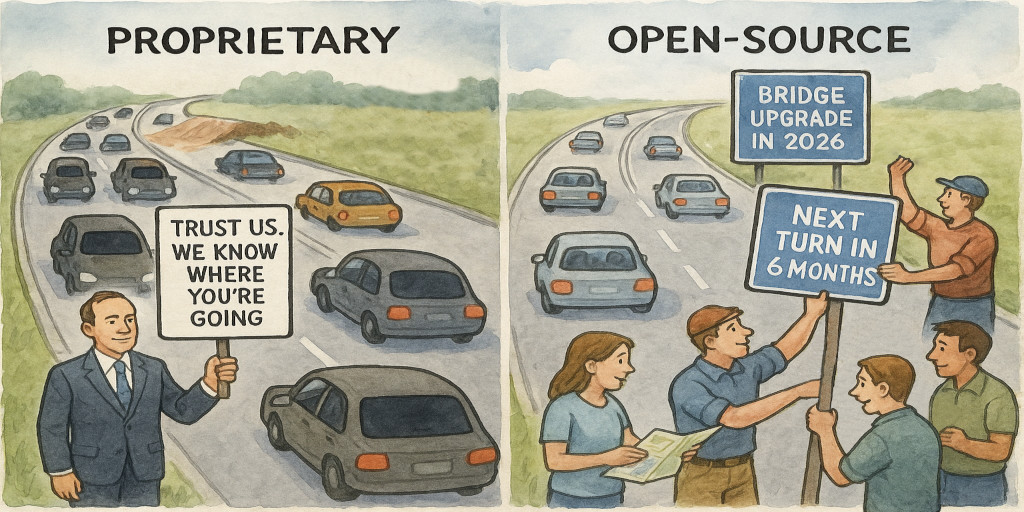Commercial Pain Points: Opaque Roadmap
| Published: | Tuesday, September 2, 2025 |
| Author: | Daniel Patterson |
The Cost of Secrecy
One of the most defining characteristics of working with commercial software vendors is the veil of secrecy that shrouds their product development processes. Customers are asked to trust vendors without access to any meaningful information about what is being built, when it will be available, or whether their needs will ever be addressed. Far from incidental, this secrecy is deliberate.
Even in cases where court proceedings have forced companies to disclose aspects of their development pipeline, vendors almost universally defend their right to withhold information under the banner of trade secrets. The legal system itself, in nearly every measurable circumstance, has reinforced the position of protecting the vendor's right to secrecy, even at the direct expense of customers who rely on their products. Time and again, vendors would rather risk alienating their paying clients than risk surrendering even a minor function, a single algorithm, calculation, or interface design, to a competitor.
While competition can fuel innovation, the wholesale prioritization of secrecy completely undermines the cooperative spirit required for human civilization to truly flourish. Progress at scale demands shared platforms, open processes, and collaborative problem-solving. When dozens, or even thousands, of groups must independently duplicate work simply because knowledge is locked behind proprietary barriers, the global pace of innovation slows to a crawl. Meanwhile, the future demands overwhelming cooperation in the form of multiple groups working on the same foundational systems, advancing unique and independent goals without ever duplicating labor that has already been completed elsewhere.
The Hidden Paths of Proprietary Development
When engaging with proprietary software vendors, customers operate in a near-total absence of visibility. The vendor's roadmap is internal, malleable, seemingly draconian, and hidden by design. The opacity benefits the vendor, who maintains total control over priorities, timelines, and product direction, while leaving all of their customers in the dark.
Feature requests and bug reports, even when collected through formalized feedback portals, rarely translate into visible action. Many enterprise customers can share anecdotes of submitting high-priority requests, only to wait years, or indefinitely, without a resolution. One CIO recently described the process bluntly: "We don't influence the roadmap. We can only adapt when it arrives."
This lack of control exposes organizations to strategic risk. A vendor may suddenly pivot away from a product line, introduce disruptive licensing changes, or sunset a feature that underpins a customer's operations. In the most extreme cases, such as Oracle's abrupt changes to Java licensing or Adobe's rapid shift to cloud-based subscription models, customers are left scrambling to retool systems or renegotiate budgets on timelines they did not choose.
The Open-Source Alternative: Transparency as a Feature
Open-source projects can easily invert this dynamic. Transparency isn't an afterthought but a structural principle. Roadmaps are frequently published openly, either in project repositories, developer mailing lists, or community forums. Even when disagreements arise, users know that their input is welcomed and their voices are part of the conversation.
For example, the Linux kernel community regularly publishes long-term support schedules, ensuring enterprises can plan their upgrade cycles years in advance. Similarly, the PostgreSQL project posts detailed development milestones, often announcing new features well before they are finalized. This openness empowers organizations to align their technical strategies with predictable development timelines.
Additionally, open-source communities thrive on dialogue. A bug report doesn't vanish into a void, but instead becomes part of a collaborative process. Sometimes the community rejects a suggestion, but even then, the reasoning is documented in public. You can contrast this with your experiences with proprietary vendors, where silence, or a rubber-stamped "thank you for your feedback", is the default response.
Case Study: Kubernetes and Predictable Evolution
Kubernetes, now a cornerstone of modern cloud infrastructure, illustrates the cooperative power of transparency. Its development roadmap is public, meticulously tracked, and debated in open meetings. Enterprises that depend on Kubernetes can prepare not only for near-term changes, such as API obsolescence, but also for long-term architectural shifts.
The result is a global ecosystem of companies, both large and small, that build on Kubernetes with confidence. Competing organizations do contribute to the same codebase, but instead of duplicating effort, they push the platform forward together while differentiating themselves in higher-level services. This represents a picture of cooperation at scale, where competition thrives on shared infrastructure, instead of the repeated reinvention of identical foundations.
Conclusion: Choosing the Future
You might be interested to find that the opaque roadmap of proprietary vendors is more than a simple inconvenience; it is a structural barrier that limits civilization's ability to plan, innovate, and thrive. By treating customers as passive consumers rather than stakeholders of their own futures, vendors may preserve their secrecy but sacrifice all trust in the process.
Open-source projects, in contrast, build trust through transparency and cooperation. They allow organizations to anticipate change, prepare strategies, and contribute to the direction of the tools they depend on. Perhaps most importantly, they embody the kind of cooperative ethos humanity needs for progress, where wasteful duplication of effort is minimized, knowledge is shared, and independent goals are achieved on a foundation of collective labor.
The choice is not simply between open and closed software. It is a choice between two visions of the future. In one scenario, progress is fragmented and proprietary, while in another, it is cumulative, transparent, and shared.
 werMake
werMake